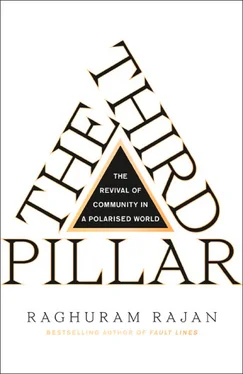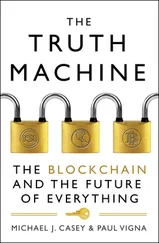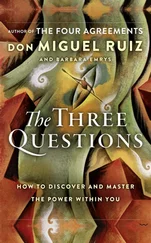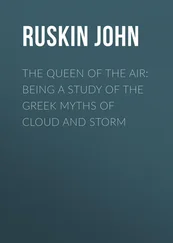The rest of this book is as follows. I start by describing the third pillar, the community. To some, the community stands for warmth and support. To others, it represents narrow-mindedness and traditionalism. Both descriptions can be true, sometimes simultaneously, and we will see why. The challenge for the modern community is to get more of the good while minimising the bad. We will see how this can be obtained through the balancing influence of the other two pillars – the state and markets. To continue our exploration, we must understand how these pillars emerged historically. In Part I, I trace how the state and markets in today’s advanced countries grew out of the feudal community, taking over some of its activities. I explain how a vibrant market helped create independent sources of power that limited the arbitrary powers of the state. As the state became constitutionally limited, markets got the upper hand, sometimes to the detriment of communities. The extension of suffrage reempowered communities and they used it to press the state to impose regulatory limits on the market. People also demanded reliable social protections that would buffer them against market volatility. All these influences came together in the liberal market democracies, which emerged across the developed world in the early twentieth century. However, market downturns, especially following technological revolutions, were, and are, disruptive. The Great Depression, followed by the Second World War, seemed to sound the death knell of liberal market democracies in much of the world, and the ascent of the state.
In Part II, I describe how the United States shaped the postwar liberal order, and how both the state and markets grew once again. Democracy was given firmer roots. The thirty years of strong postwar growth, however, were followed by years of relative stagnation as developed countries struggled for new ways of reviving growth. In response, the Anglo-American countries empowered the markets at the expense of the state, while continental European reforms favoured the superstate and the integrated market. Both sets of reforms came at the expense of the community. These different choices left countries differently positioned for the ICT revolution, the subsequent Global Financial Crisis, and the backlash against the global order. I describe the reasons for the rise of populism and trace related developments in China and India.
I turn to possible solutions in Part III. To strengthen the chances that society will stay liberal and democratic, we need profound changes that rebalance the three pillars in the face of technological change. We need more localism to empower the community while drawing on the state and markets to make society more inclusive.
Finally, some caveats. I intend this book to be comprehensive, but not exhaustive. Therefore, I illustrate the course of history with examples from prominent countries, but it would tax the reader’s patience (as well as my editor’s) if I substantiated points with the detail that specialists require. This book offers a broad thesis of its own, and draws on much academic work, but it is aimed at a wide audience. I also offer policy proposals, not as the final word but to provoke debate. We face enormous challenges, to which we need not just the right solutions but also ones that inspire us to act. It is worth recalling the words of Chicago architect Daniel Burnham, ‘Make no little plans; they have no magic to stir men’s blood and probably themselves will not be realized.’ 11I hope this book stirs your blood.
INTRODUCTION
THE THIRD PILLAR
Why do our neighbours matter when we can reach people across the world with a click? What role do proximate communities play today in an advanced country that has both a well-functioning state and vibrant markets? Despite the state and markets having taken up many of the early community’s functions, the proximate community still performs important ones. It helps define who we are. It gives us a sense of empowerment, an ability to shape our own futures in the face of global forces. It also offers us help in times of adversity when no one else will. Of course, the community can also be narrow-minded, traditional, and resistant to change. A successful modern community supports its members even while being more open, inclusive, and dynamic. We will see why it is difficult for a community to do all this, but also why it is necessary if the community is to address the problems we face.
THE PROXIMATE COMMUNITY
We are shaped by the people who surround us. Our joys are more pleasurable when they are cherished by our friends, our successes more enjoyable when they are applauded by those whose opinions we care about, our protests are less lonely and our indignation less unsure when shared by our supporters, our hatreds more corrosive when goaded by fellow zealots, our sorrows less burdensome when borne with our family. Moreover, we gauge our actions based on how they affect people near us, on the indentations our actions make on their lives. Without such effects, we would be ephemeral passersby, with little evidence of ever having existed. Each one of us draws from multiple overlapping communities that help define who we are, that give us identity over and above the core we think is uniquely us.
There are varieties of communities, some more tightly bound than others. A community could be a group of people who are linked together by blood (as a family or clan) or who share current or past physical proximity (as people in, or having emigrated from, a village). A community could be those who have a common view on how to live a good life (as in a religious sect), share a common profession (as in the movie industry), or frequent the same website or chat groups (as in my college alumni group, where everyone seems to have a different opinion on everything that they absolutely must express). Each one of us has multiple identities, based on the groups we belong to. 1Moreover, some of us have virtual identities in addition to real ones.
As communication has improved, and transportations costs have come down, more distant communities have gained importance. For some of us, these communities may be much more important than our neighbourhood. Indeed, a central concern in this book is about the passions that are unleashed when an imagined community like the nation fulfills the need for belonging that the neighbourhood can no longer meet.
Nevertheless, we will focus on the proximate community for much of the book for a variety of reasons. Through most of history when distances really mattered, it was the only kind of community that had a serious influence on most people’s lives. Even today, it is where much economic activity is centered. For most of us, the neighbourhood is still what we encounter every day, and what anchors us to the real world. It is where we participate as sociable humans, not as clan members, co-religionists, professionals, or disembodied opinions on the web. It is where we have the best chance of persuading others that our humanity unites us more than our ethnicity, profession, or national origin differentiates us. It certainly is where we debate and persuade as we elect officeholders and participate in the governance of the local public services that affect us. It is where we congregate to start broader political movements. As we will see later in the book, a healthy, engaged, proximate community may therefore be how we manage the tension between the inherited tribalism in all of us and the requirements of a large, diverse nation. Looking to the future, as more production and service jobs are automated, the human need for relationships and the social needs of the neighbourhood may well provide many of the jobs of tomorrow.
In closely knit communities, a variety of transactions take place without the use of money or enforceable contracts. One side may get all the benefits in some transactions. Sometimes, the expectation is that the other side will repay the favour, but this may never actually happen. In a normal family, members typically help one another without drawing up papers and making payments. In many societies, friends don’t really care who pays the bill at dinner, indeed the ability to not keep count is the mark of true friendship.
Читать дальше












